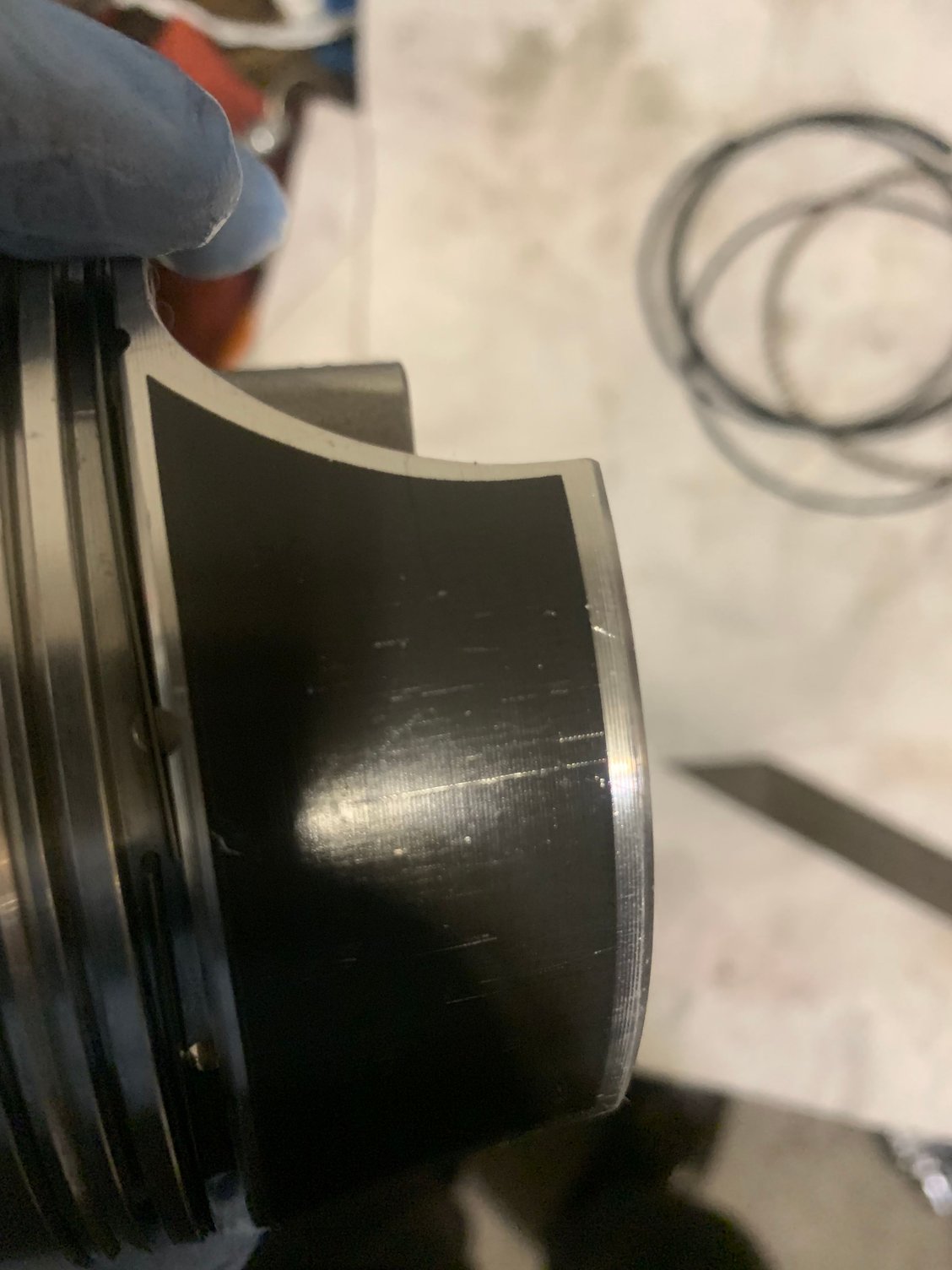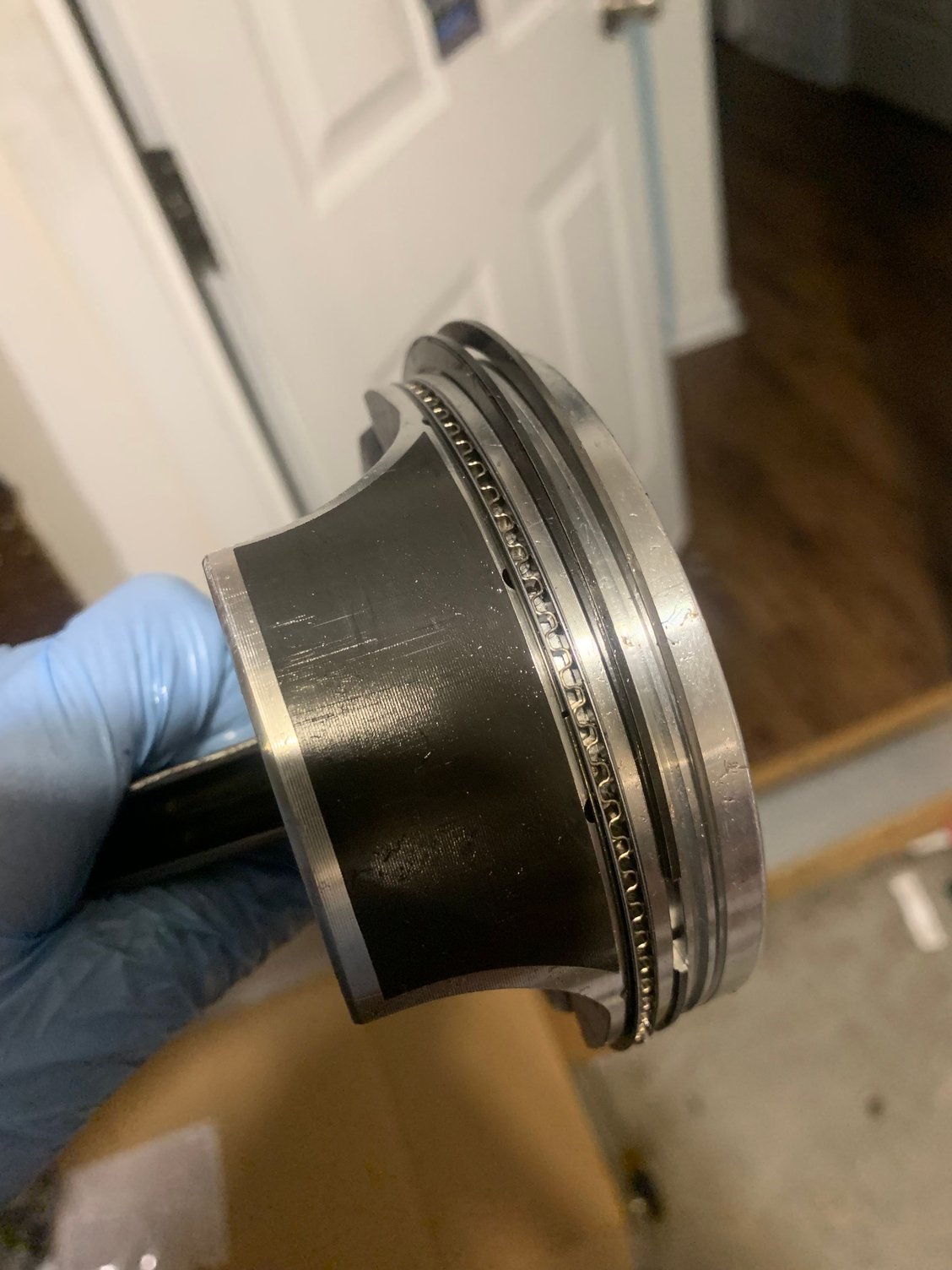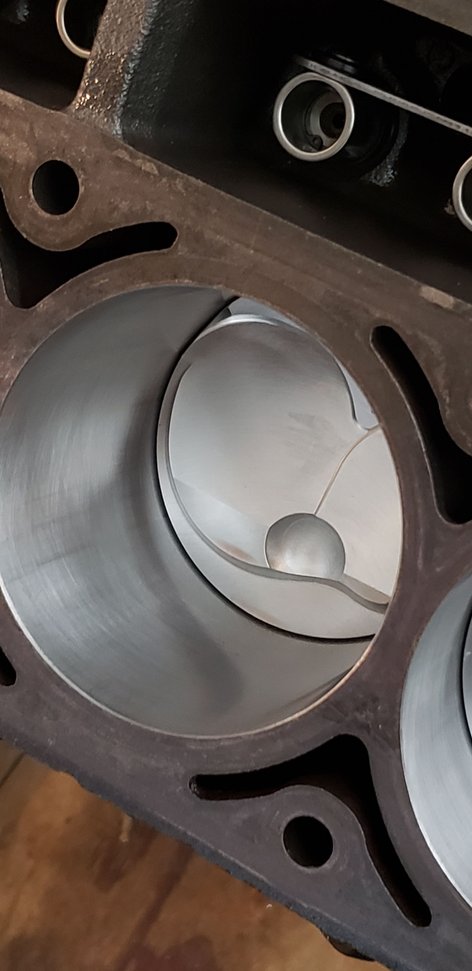Damaged cross hatching during assembly
#21
There is no burs, i handled the burs when i gapped the rings.
I just cleaned the **** out of the engine and took a piston cleaned it to the point where you could eat of of it and it still is doing this.
I just cleaned the **** out of the engine and took a piston cleaned it to the point where you could eat of of it and it still is doing this.
#28
#29
4032 will run tighter than 2618. My 4.070" JE SRP pistons are 4032 and they recommend .0020"-.0025" clearance.
I'm not seeing anything completely alarming. A few scratches can be expected during assembly. What I see in your pic looks like debris that didn't get removed during cleaning.
I use the "white glove" method where the cylinder wall is cleaned with brake clean using blue shop towels first, then white lint free cloths until there is NOTHING showing on the towel.
After cleaning, I oil the cylinder with a clean white towel and "rub it in" from top to bottom and "diagonal" following the cross hatch. If I see anything on the white towels at any point, I go back to step 1 and re-clean and re-oil the cylinder again.
Wash-rinse-repeat for the other 7 cylinders. It takes time, but worth the effort in my opinion.
Cole
I'm not seeing anything completely alarming. A few scratches can be expected during assembly. What I see in your pic looks like debris that didn't get removed during cleaning.
I use the "white glove" method where the cylinder wall is cleaned with brake clean using blue shop towels first, then white lint free cloths until there is NOTHING showing on the towel.
After cleaning, I oil the cylinder with a clean white towel and "rub it in" from top to bottom and "diagonal" following the cross hatch. If I see anything on the white towels at any point, I go back to step 1 and re-clean and re-oil the cylinder again.
Wash-rinse-repeat for the other 7 cylinders. It takes time, but worth the effort in my opinion.
Cole
The following users liked this post:
Che70velle (07-19-2019)
#31
Are you just putting new pistons in a new block that hasn't been machined? PLEASE tell me this isn't the case!
Did you measure and set the ring gap?
#32
4032 will run tighter than 2618. My 4.070" JE SRP pistons are 4032 and they recommend .0020"-.0025" clearance.
I'm not seeing anything completely alarming. A few scratches can be expected during assembly. What I see in your pic looks like debris that didn't get removed during cleaning.
I use the "white glove" method where the cylinder wall is cleaned with brake clean using blue shop towels first, then white lint free cloths until there is NOTHING showing on the towel.
After cleaning, I oil the cylinder with a clean white towel and "rub it in" from top to bottom and "diagonal" following the cross hatch. If I see anything on the white towels at any point, I go back to step 1 and re-clean and re-oil the cylinder again.
Wash-rinse-repeat for the other 7 cylinders. It takes time, but worth the effort in my opinion.
Cole
I'm not seeing anything completely alarming. A few scratches can be expected during assembly. What I see in your pic looks like debris that didn't get removed during cleaning.
I use the "white glove" method where the cylinder wall is cleaned with brake clean using blue shop towels first, then white lint free cloths until there is NOTHING showing on the towel.
After cleaning, I oil the cylinder with a clean white towel and "rub it in" from top to bottom and "diagonal" following the cross hatch. If I see anything on the white towels at any point, I go back to step 1 and re-clean and re-oil the cylinder again.
Wash-rinse-repeat for the other 7 cylinders. It takes time, but worth the effort in my opinion.
Cole
Whipped out all the gray with a paper towel
blasted it with break cleaner
whipped all out with a paper tower
and I do this until it comes out white throwing the paper towel out as I go
inspect for lint
-------------
the pistons I disassembled and cleaned with a tooth brush
same clean until white paper tower is spot less
----------
I am getting a bore gauge and the mic and i'm going to check it. with a feeler gauge it is more than .0025 but not 100% how exact it is.
#34
I rehoned (and will again)
Whipped out all the gray with a paper towel
blasted it with break cleaner
whipped all out with a paper tower
and I do this until it comes out white throwing the paper towel out as I go
inspect for lint
-------------
the pistons I disassembled and cleaned with a tooth brush
same clean until white paper tower is spot less
----------
I am getting a bore gauge and the mic and i'm going to check it. with a feeler gauge it is more than .0025 but not 100% how exact it is.
Whipped out all the gray with a paper towel
blasted it with break cleaner
whipped all out with a paper tower
and I do this until it comes out white throwing the paper towel out as I go
inspect for lint
-------------
the pistons I disassembled and cleaned with a tooth brush
same clean until white paper tower is spot less
----------
I am getting a bore gauge and the mic and i'm going to check it. with a feeler gauge it is more than .0025 but not 100% how exact it is.
#35
Itís a brand new block. Why would it need to be machined?
#36
A feeler gauge is not the tool you need to check the clearances. Bore gauges require some finess and proper training to use correctly. Same with a mic. You must know WHERE to measure the piston at. Same with the bores. Youíll need to figure bore taper, which Iím sure youíve got since youíve honed on them some yourself. You should enlist the help of a good machinist to tell you where you are with the numbers of all 8 holes. Youíve honed a little with a dingle and likely your numbers are all over the place.
#37
I'm helping a buddy with a "warm" 350 for his boat. His dad didn't de-winterize it before taking it out this spring, and overheated the crap out of it. The engine had 575 hours, and was happy and healthy before the thermal event.
Anyway, the cast SpeedPro pistons all showed less skirt-coating wear after 575 hours of marine use, than your new piston skirts do.

Anyway, the cast SpeedPro pistons all showed less skirt-coating wear after 575 hours of marine use, than your new piston skirts do.

#38
Because you can't properly hone a block without first having the pistons that are going to be installed and then measure those same pistons to determine the proper amount of clearance required.
If you are purchasing a new GM block that has been completely machined to PRODUCTION tolerances and installing factory OEM pistons, you can expect to be able to just slap it together and it should run. But keep in mind, the production tolerance aspects. From what has been posted, your build is not using factory OEM pistons and therefore you can't expect the pre-honed bore to be correct AT ALL for the components you are using. The OEM pistons are made of a cast material with a different expansion rate than the 4032 pistons you are using, so this alone will require AT A MINIMUM verification of the piston to wall clearances using the proper measuring equipment.
You should always strive for better than production tolerances if not exactly perfect when it comes to piston to bore clearances. It will only ensure longevity and expected performance.
No disrespect at all because I don't know your measurement capabilities, but a mic is not a mic, and certainly a bore gage is not a bore gage. There is a BIG difference in quality, precision and repeatability.
What I'm saying is that there is a "feel" that is learned when measuring to the precision required to properly determine piston to bore clearances. A cheap Harbor Freight mic and/or bore gage isn't going to cut it for this job. The mic in this case is less critical since you don't really care about what the actual measurement of the piston diameter is, but are only using the mic to "set" the bore gage to measure the DIFFERENCE in size of the bore. How you measure and "sweep" the bore gage is what is critical to obtaining an accurate and reliable measurement.
Cole
If you are purchasing a new GM block that has been completely machined to PRODUCTION tolerances and installing factory OEM pistons, you can expect to be able to just slap it together and it should run. But keep in mind, the production tolerance aspects. From what has been posted, your build is not using factory OEM pistons and therefore you can't expect the pre-honed bore to be correct AT ALL for the components you are using. The OEM pistons are made of a cast material with a different expansion rate than the 4032 pistons you are using, so this alone will require AT A MINIMUM verification of the piston to wall clearances using the proper measuring equipment.
You should always strive for better than production tolerances if not exactly perfect when it comes to piston to bore clearances. It will only ensure longevity and expected performance.
What I'm saying is that there is a "feel" that is learned when measuring to the precision required to properly determine piston to bore clearances. A cheap Harbor Freight mic and/or bore gage isn't going to cut it for this job. The mic in this case is less critical since you don't really care about what the actual measurement of the piston diameter is, but are only using the mic to "set" the bore gage to measure the DIFFERENCE in size of the bore. How you measure and "sweep" the bore gage is what is critical to obtaining an accurate and reliable measurement.
Cole
#39
For what itís worth, our last build used a GM LS3 block out of the box and Mahle 4.065 forged pistons - but you bet everything was measured to the .000x to verify fitment.
The bores were better machined than any Iíve seen from a local machine shop in years.
The bores were better machined than any Iíve seen from a local machine shop in years.
#40
You seem to be getting awful snotty with those who are trying to help you and explain proper engine building practices to you. You can't just buy a block and pistons and shove them together without checking clearances. Assuming that just because it's new means it has to be right.......will result in posting on forums to find out what's wrong. And you'll NEVER get that block clean sitting in a bathtub with nothing but brake cleaner and paper towels. It needs to be on a stand, outside, and scrubbed for hours with the proper brushes inserted into a drill with LOTS of water and soap. If you can't feel those marks, don't sweat it. As has been shown, most of the time installing pistons leaves shadows in the bore........just like checking bearing clearances (properly, with a bore gauge) leaves shadows on the bearing.









